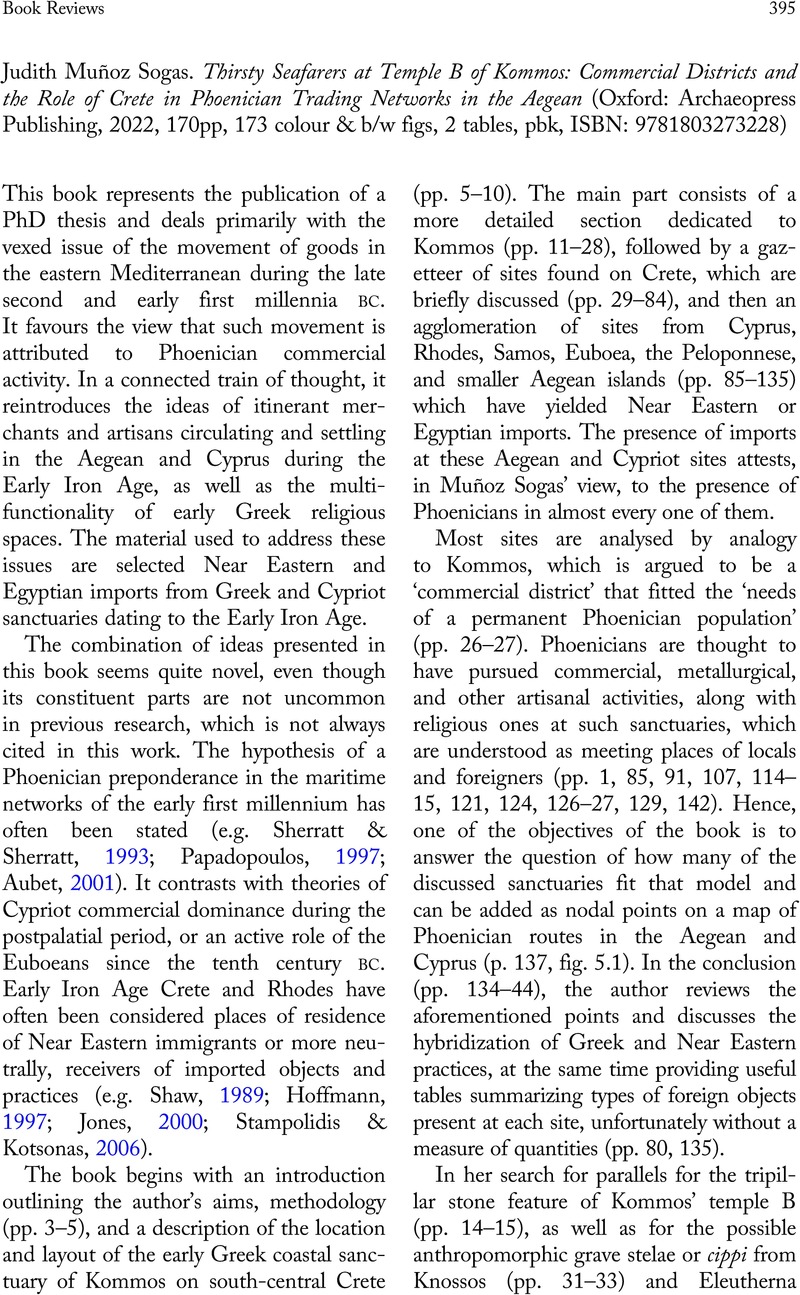No CrossRef data available.
Article contents
Judith Muñoz Sogas. Thirsty Seafarers at Temple B of Kommos: Commercial Districts and the Role of Crete in Phoenician Trading Networks in the Aegean (Oxford: Archaeopress Publishing, 2022, 170pp, 173 colour & b/w figs, 2 tables, pbk, ISBN: 9781803273228)
Review products
Judith Muñoz Sogas. Thirsty Seafarers at Temple B of Kommos: Commercial Districts and the Role of Crete in Phoenician Trading Networks in the Aegean (Oxford: Archaeopress Publishing, 2022, 170pp, 173 colour & b/w figs, 2 tables, pbk, ISBN: 9781803273228)
Published online by Cambridge University Press: 13 July 2023
Abstract
An abstract is not available for this content so a preview has been provided. Please use the Get access link above for information on how to access this content.

- Type
- Book Review
- Information
- Copyright
- Copyright © The Author(s), 2023. Published by Cambridge University Press on behalf of the European Association of Archaeologists
References
Aubet, M.E. 2001. The Phoenicians and the West: Politics, Colonies, and Trade, 2nd edn. Cambridge: Cambridge University Press.Google Scholar
Brock, J.K. 1957. Fortetsa: Early Greek Tombs Near Knossos. Cambridge: Cambridge University Press.Google Scholar
Coldstream, J.N. & Catling, H. eds. 1996. Knossos North Cemetery: Early Greek Tombs. London: The British School at Athens.Google Scholar
Foxhall, L. 1998. Cargoes of the Heart's Desire: The Character of Trade in the Early Mediterranean World. In: Fisher, N. & van Wees, H. eds., Archaic Greece: New Approaches and Evidence. London: The Classical Press of Wales, pp. 295–310.CrossRefGoogle Scholar
Hoffmann, G.L. 1997. Imports and Immigrants: Near Eastern Contacts with Iron Age Crete. Ann Arbor: The University of Michigan Press.Google Scholar
Hölbl, G. 2022. The Shrine of Eileithyia: Minoan Goddess of Childbirth and Motherhood at the Inatos Cave in Southern Crete. Vol. 1, The Egyptian-Type Artifacts. Philadelphia: INSTAP Academic Press.Google Scholar
Jackson, L. 2020. Sekhmet and Bastet: The Feline Powers of Ancient Egypt, 2nd edn. London: Avalonia.Google Scholar
Jones, S. 1997. The Archaeology of Ethnicity: Constructing Identities in the Past and Present. London: Routledge.Google Scholar
Jones, D.W. 2000. External Relations of Early Iron Age Crete, 1100–600 BC. Philadelphia: Archaeological Institute of America.Google Scholar
Meskell, L. 2004. Object Worlds in Ancient Egypt. Material Biographies Past and Present. New York: Routledge.Google Scholar
Papadopoulos, J. 1997. Phantom Euboeans. Journal of Mediterranean Archaeology, 1: 191–217.Google Scholar
Prent, M. 2005. Cretan Sanctuaries and Cults: Continuity and Change from Late Minoan IIIC to the Archaic Period. Leiden: Brill.CrossRefGoogle Scholar
Shaw, J.W. 1989. Phoenicians in Southern Crete. American Journal of Arcaheology, 93: 165–83.CrossRefGoogle Scholar
Shaw, J.W. & Shaw, M.C eds. 2000. Kommos IV: The Early Greek Sanctuary. Princeton: Princeton University Press.Google Scholar
Sherratt, S. & Sherratt, A. 1993. ‘The Growth of the Mediterranean Economy in the Early First Millennium, World Archaeology, 24: 361–78.CrossRefGoogle Scholar
Stampolidis, N. & Kotsonas, A. 2006. Phoenicians in Crete. In: Deger-Jakoltzy, S. & Lemos, I. eds., Ancient Greece: From the Mycenaean Palaces to the Age of Homer. Edinburgh: Edinburgh University Press, pp. 337–60.CrossRefGoogle Scholar




